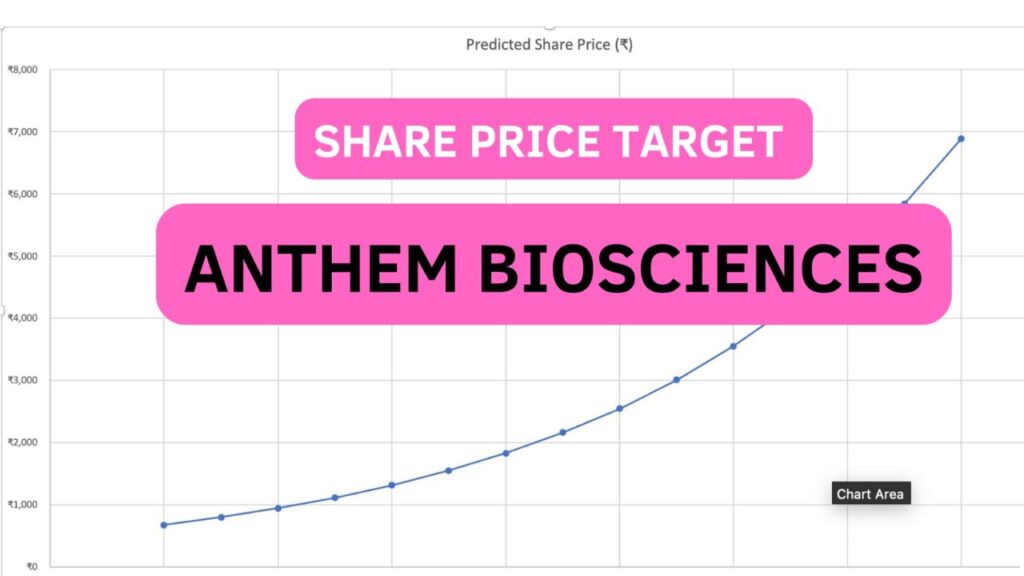Before jumping into future targets, it’s critical to ground ourselves in Anthem’s current footprint, financials, and market sentiment. The farther out you project, the more each assumption matters.
Company Profile & Business Model
- Anthem Biosciences is a CRDMO (Contract Research, Development & Manufacturing Organization) player, with operations in drug discovery, development, biologics, specialty ingredients, etc.
- It operates across multiple modalities: small molecules, biologics, fermentation processes, specialty ingredients.
- As of mid-2025, management has communicated that the company expects to generate about ₹300 crore annually in cash, some of which will be used to bring up new manufacturing facilities.
- Its IPO was conducted as an offer for sale (i.e. no fresh shares issued), in the price band ₹540–₹570.
- The listing was strong: shares listed at ₹723.10 and closed near ₹731.65 vs issue price ₹570 — about a ~27-28% first‐day premium.
- Financials (from IPO documents) for FY 2025: revenue ~₹1,844.55 crore, net income ~₹451.26 crore, margin ~24.46%.
- At the IPO price, its P/E was projected to be in the 66.9 – 70.6× range.
- Analysts and aggregators (SimplyWallSt) project earnings growth (CAGR) at ~22% and revenue growth ~19.5%.
So the base case “story” is: high growth, high valuation, yet the risk of executing in a competitive, capital-intensive domain.
Market Sentiment & Near-Term Targets
- On Investing.com, consensus 12-month target is ₹820.
- Some brokers and market watchers view ₹900 as a short/medium target. Longer term, some mention ₹1,000+ as aspirational.
- Given the high valuation already baked in, many commentaries caution that margin stability, execution, and scaling will matter heavily.
With that background, we can move on to plausible projections.
Scenario Framework & Key Assumptions
Because projecting 5–10 years ahead involves compounding error, I’ll present three scenarios (bear, base, bull) and then provide plausible target ranges. Here are the variables that matter most:
- Revenue Growth Rate — how fast the top line expands.
- Margin / Profitability — whether operating margins hold or improve.
- Valuation Multiple / Re-rating — whether the market rewards the growth (or reverses it).
- Capital Intensity and Investment — how much capital is required to scale, and whether that dilutes returns.
- Risks & Execution — regulatory, competition, technological change, execution missteps.
I’ll anchor the base case to growth estimates from analysts (20–22% earnings, ~19–20% revenue) and then vary margins and multiples in bear and bull cases.
Let me define a shorthand:
- Base growth: revenue growth ~15–20% CAGR, EPS growth ~18–22%, margins holding or improving moderately
- Bear growth: revenue growth ~8–12% CAGR, pressure on margins
- Bull growth: revenue growth ~20–25%+, margin expansion, plus re-rating
Valuation multiples: base case might assume P/E moving gradually from current levels to something more modest but still generous. Bear case might see multiple compression; bull case may allow expansion of valuation.
I’ll present target ranges (in Indian Rupees) for 2025–2030 under each scenario, then suggest “central” or most plausible estimates.
Price Target Projections: 2025 to 2030
Below is a table with three scenarios (Bear, Base, Bull) and the target ranges.
| Year | Bear Case | Base Case | Bull Case |
|---|---|---|---|
| 2025 | ₹650 – ₹850 | ₹800 – ₹950 | ₹900 – ₹1,100 |
| 2026 | ₹750 – ₹1,000 | ₹950 – ₹1,200 | ₹1,100 – ₹1,450 |
| 2027 | ₹850 – ₹1,200 | ₹1,100 – ₹1,500 | ₹1,350 – ₹1,900 |
| 2028 | ₹1,000 – ₹1,400 | ₹1,300 – ₹1,800 | ₹1,700 – ₹2,400 |
| 2029 | ₹1,200 – ₹1,600 | ₹1,600 – ₹2,200 | ₹2,100 – ₹3,000 |
| 2030 | ₹1,400 – ₹2,000 | ₹1,900 – ₹2,700 | ₹2,700 – ₹3,700 |
Interpretations & “Most Likely” Picks
- Under the bear case, the stock still moves upward from listing levels but at a more conservative pace, constrained by margin pressure or lower multiples.
- The bull case assumes smoother scaling, margin expansion, perhaps greater global contracts, and favorable valuation re-rating.
- The base case is what I’d lean toward personally, given the background and risk environment.
Hence, for the base case, my realistic targets are:
- 2025: ~₹850 – ₹950
- 2026: ~₹1,050 – ₹1,200
- 2027: ~₹1,300 – ₹1,500
- 2028: ~₹1,500 – ₹1,800
- 2029: ~₹1,800 – ₹2,200
- 2030: ~₹2,200 – ₹2,700
If I were forced to pick a central path, I might say: ₹900 in 2025; ₹1,150 in 2026; ₹1,400 in 2027; ₹1,650 in 2028; ₹2,000 in 2029; ₹2,400 in 2030.
Note: These are based on rupee values, as Anthem is listed in India.
What Could Pull These Off — or Push Them Down
Let me walk you through what it would take for these targets to materialize or fail.
Upside Drivers (Bull Case Inputs)
- Strong global contract wins
If Anthem can get major contracts from big pharma / biotech abroad, with multi-year revenue commitments. - Margin expansion via efficiency / scale
As fixed costs spread, process optimization, or technology improvements can push margins higher. - Valuation multiple re-rating
If markets start attributing lower risk to biotech/CRDMO stocks, or grant higher P/E multiples. - New capabilities / product lines
If the company enters higher-barrier services (e.g. complex biologics, biosimilars) that command premium margins. - Favorable macro, pharma outsourcing trends
Global supply chain shifts away from China / pressures in other markets may push outsourcing demand toward India.
Risks / Headwinds (Bear Case Inputs)
- Execution missteps / scaling challenge
Problems in facility buildouts, quality control, regulatory compliance could slow growth or impair margins. - Margin pressure / input cost inflation
Rising raw material, energy, regulatory compliance costs, or adverse forex movement. - Valuation reversal / multiple contraction
If investors become wary, growth stocks may suffer compression. Even strong earnings may fail to result in price gains. - Global competition / regulatory hurdles
Competition from established CDMOs around the world, regulatory risks in drug / biologics manufacturing, IP / compliance risks. - Capital intensity / dilution
If scaling requires heavy capital spending, debt, or equity dilution, returns may be diluted.
Sensitivity
- A 1–2% shift in margin assumptions or 2–3× shift in multiples can make large differences in target outcomes.
- Foreign exchange risk matters: many contracts may be denominated in USD or other currencies, so rupee strength or weakness will affect effective value.
How These Compare to Published Forecasts
A few external forecasts offer ranges that are useful to compare with:
- One site (TheTaxHeaven) published a projection:
- 2025: ₹720 – ₹770
- 2026: ₹780 – ₹860
- 2027: ₹870 – ₹980
- 2028: ₹990 – ₹1,100
- 2029: ₹1,120 – ₹1,280
- 2030: ₹1,300 – ₹1,500
These seem conservative, especially in later years compared to my base and bull cases.
- Some commentaries see short-term ₹900 and long-term ₹1,000+ as achievable.
- SimplyWallSt points to projected earnings growth ~22% annually and revenue growth ~19.5%.
So my base / bull cases are somewhat more bullish than the most conservative external forecasts but not wildly so given the growth assumptions.
What I’d Monitor Over Time
When tracking Anthem’s real performance, here are the critical indicators I’d watch — they’d make me adjust my projections up or down.
- Quarterly revenue & margin trends — whether it meets or beats guided growth and margin thresholds.
- New contract announcements / order backlog — evidence of sustained demand.
- Capital expenditure vs return — how much cash is being invested, and how returns scale.
- Operating leverage — whether fixed cost absorption gives margin expansion or if expenses scale faster.
- Valuation peer multiples — whether similar CRDMO / biotech firms are getting higher or lower P/E multiples.
- Macro / regulatory environment — policy incentives, export / pharma regulation, competition.
If in a future year Anthem outpaces revenue growth, beats margins, and global demand is strong, I’d tilt toward the upper halves of my ranges. Conversely, if growth stumbles or margins compress, I’d float toward the lower parts.
Final Thoughts & Cautions
- A company like Anthem, fresh off IPO and operating in a specialized, technical domain, carries both high upside and high execution risk.
- My base case is realistic but optimistic: I believe it’s plausible for Anthem to touch ₹1,400–₹1,600 by 2027 if things go well, and to reach ₹2,400+ by 2030 in a favorable scenario.
- The bear case is also nontrivial: it assumes that growth faces headwinds, scaling is harder, and valuation multiples compress.
- Because it’s early days, these projections are wide — perhaps too wide to trade around precisely. What matters more is watching how fundamentals evolve.



